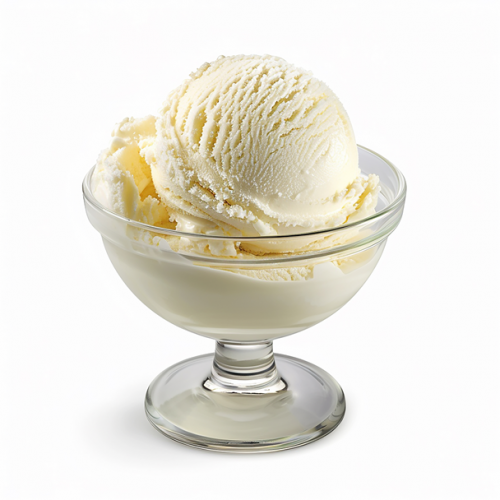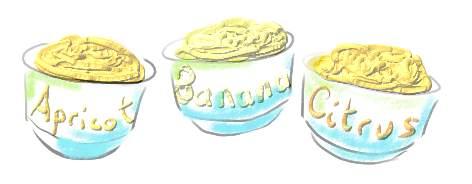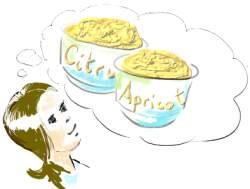Ice cream
In the café, your ice cream selection can't include a combination that someone else has chosen. What could these seven children have chosen?
Problem
In this café, you can choose ice cream from different tubs.

The flavours are Apricot, Banana and Citrus.
There is only one rule about what you can choose, and here it is: your ice cream selection can't include a combination that someone else has chosen.
This means that if someone has chosen Banana and Citrus, I can't have all three flavours, but I could choose to have any one of the three flavours on its own.
So perhaps Sarah, the first child, chooses Apricot and Citrus.
Tim, the second child, chooses Banana and Citrus. (This obeys the rule because Sarah's choice was not Banana on its own, nor was it Citrus on its own.)
Raj, the third child, chooses Citrus.
Zoe, the fourth child, chooses Banana.
Matt has to be the last child, because he can only choose Apricot and then there are no other choices left.
In this example, with these children making these choices, only five children can have ice cream.
But suppose more children wanted ice cream and so they got together to work out how this could be done.
They might come up with an idea like this, where A is Apricot, B is Banana and C is Citrus:
1st choice: A B C
2nd choice: A B
3rd choice: A C
4th choice: B C
5th choice: A
6th choice: B
7th choice: C
So seven children altogether. I think that the children can have different sized scoops so that even if they only have one flavour they have as much ice cream as someone choosing three flavours!
If these children came up with the worst way, that would be like this:
1st choice: A
2nd choice: B
3rd choice: C
And that's all!
So that's what it's like when there are three flavours. At the most, seven children can go in that order and get those choices of ice cream. At worst, only three children can go and get ice cream.
Are there any other ways that seven children could all get ice cream? Remember that when someone goes up and makes their choice they have to obey the rule: their ice cream selection can't include a combination that someone else has chosen.
Once you've done that, have a go at asking: "I wonder what would happen if...?"
Getting Started
This investigation is a little different from many because the order is so very important - have you checked you have stuck to the rule?
What could you choose next? Is there a way you can select flavours so that more people will have a choice after you?
It might help to record your working.
Student Solutions
Jaeyoon from Forest Elementary School in South Korea sent in the following:
Let's do this in general. Suppose you want as many kids as possible to at some flavour(s) from the ice-cream cafe and there are x flavours. What is the maximum number of kids that they can all eat ice-cream, so that nobody has exactly the same combination of other kids?
Let's first find out the pattern. Let's say there is one flavour: A. Directly, you can see there are 2 possibilities: Eat A, Do not eat A. But not eating A means eating nothing in this case. So, only Child 1 can eat ice-cream: Flavour A.
Now, let's say there are two flavours: A and B. Then, Child 1 could eat A and B, Child 2 eats A, and Child 3 eats B. The next child, Child 4 can't eat anything. So, there are three possible ways for two flavours.
As we saw, there are seven ways from three flavours. And although it might take some time, there are 15 ways for four flavours.
1, 3, 7, 15.... Let's compare this with this sequence, starting from 2, doubling every time (these numbers in the sequence are known as powers of 2): 2, 4, 8, 16.... You can see that the terms in the first sequence are one less than the second. The numbers 1, 3, 7, 15... has a special name; Mersenne numbers. And the way to generate them is to multiply 2 by itself x times, then subtract 1.
This Ice Cream problem is related with the power set. A power set is all possible distinct ways that you can have some object(s). This includes the empty set, which has no objects. And the power set of x objects is 2 multiplied by itself x times, thus, 2 to the xth power. But since we are ignoring the empty set, there are 1 fewer than 2 to the xth power ways for x flavours, which are the Mersenne numbers.
(If you want to you can find out more about these Mersenne Numbers here https://primes.utm.edu/mersenne/)
Alex and India from St Blaise School Abingdon wrote:-
We chose to do the option with four ice creams and worked our way down like a, b, c, d then a, b, c next a, b, d and so on. If you are correct you should have had fifteen people in your shop. Good Luck!
Shafiq from Beckford Primary School Camden wrote:-
We have found out that the maximum number of children who could have ice-cream was seven:
ABC, AB, CB, CA, C, A, B
What would happen if we have more flavours?
We have found out that if we have four flavours, 15 children could have ice-cream.
If we have five flavours, 31 children could have ice-cream.
We saw a pattern; each time we added a flavour, the number of children that could have ice-cream was multiplied by two, plus one more.
Cameron from the Twyford School sent in the following:-
A, B and C cannot be switched with another combination because one combination (A, B and C) will not be allowed, that will mean there will only be six combinations.
This is why I think that there will not be another possible combination according to the rules. Otherwise there would be lots more combinations than one. Here is an example:
ACB, BA, CA, CB, A, B, C
The only combination is:
ABC, AB, AC, BC, A, B, C
Although you can change the order in which the children eat the ice cream combinations, the combinations themselves essentially stay the same.
Alfie from St Aidan's Primary School wrote:
This is how many different permutations there are for all seven children getting ice cream.
We approached the problem using a basic structure:
| Number of Flavours | Combinations of Flavours | |
| Part 1 | 3 | abc |
| Part 2 | 2 | ab |
| " | 2 | bc |
| " | 2 | ca |
| Part 3 | 1 | a |
| " | 1 | b |
| " | 1 | c |
Part 1 must remain abc because it contains every other order. Parts 2 and 3 both have six permutations each
Part 2: ab,bc,ca; ab,ca,bc; bc,ab,ca; bc,ca,ab; ca,ab,bc; ca,bc,ab
and
Part 3: a,b,c; a,c,b; b,c,a; b,a,c; c,b,a; c,a,b.
This means that for each possible permutation of part 2, there are 6 permutations of part 3, so in total there are 6 x 6 permutations for the basic structure meaning 36 in total.
The issue with this is that there is another, more complex structure which obeys the rules:
| Number of flavours | Combination of Flavours | |
| Part 1 | 3 | abc |
| Part 2 | 2 | ab |
| " | 2 | ac |
| " | 1 | a |
| Part 3 | 2 | bc |
| " | 1 | b |
| " | 1 | c |
This works almost exactly as the previous structure except now the 5th choice is decided by part 2.
Part 2 has 6 combinations {ab,ca; ca,ab; ab,bc, bc, ab; ca,cb; cb,ca}
Part 3 has 2 combinations, the two different orders for the remaining single flavours of ice cream.
Therefore the total number of permutations for this structure is 6 x 2 = 12
To get the total number of permutations across both structures we have:
36 (the number of permutations for the basic structure) + 12 (the number of permutations for the complex structure) = 48
Well done! Some very thorough examplanations here. We look forward to hearing more from you all.
Teachers' Resources
Possible approach
Key questions
Possible extension
For more extension work
Possible support


